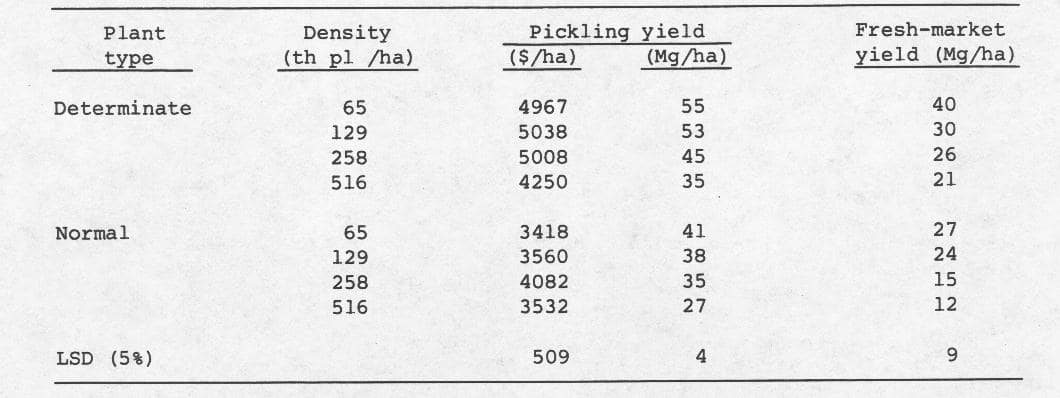Cucurbit Genetics Cooperative Report 10:29-30 (article 18) 1987
Todd C. Wehner and Conrad H. Miller
Department of Horticultural Science, North Carolina State University, Raleigh, NC 27695-7609
The determinate plant type is conditioned by a recessive, single-gene mutant (1). It causes the main stem to terminate in flower buds, and is often associated with shorter vine length as well. Our observations indicated that plants with the determinate gene have higher, more concentrated yield than the normal plants. The objective of this study was to evaluate the optimum plant density for determinate and normal cucumbers.
Methods. The experiment was run in 1981 through 1983, although we will report only the 1983 data here. Treatments included 2 crops (pickle, freshmarket), 4 determinate lines (M21, Castlepik, Spacemaster, Bush Champion), 4 normal lines of similar type, (Clinton, Calypso, Tablegreen 65, Marketmore 76), 4 densities (65, 129, 258 and 516 thousand plants per hectare), and 4 replications.
Plots were 3 x 3 m with 4 rows 0. 75 m apart in each. Alleys 1.5 m wide separated plot ends. Vine length was measured at early fruiting stage, sampling 3 plants per plot at random. Plots were harvested when fruits around 51 mm diameter (60 mm for the fresh-market lines) were observed in the check plots. The center 2 rows of each plot were harvested, leaving the border rows to provide the proper amount of competition for each density. Harvests were made twice weekly for 3 weeks, making a total of 6 for the pickling and 5 for the fresh-market cucumbers.
Results. The normal vines had 115cm-long main stem, and the determinates had 77cm-long stems. There was no difference in length between the pickling and fresh-market types.
The determinates generally had higher yield than indeterminate types, but since the lines were not isogenic, that comparison is not valid. Highest yield (as fruit weight) occurred at 65 thousand plants per hectare in both the pickling and fresh-market cucumbers for both determinate and indeterminate types (Table 1). Highest fruit value for the pickling cucumbers occurred at 129 thousand plants per hectare. In 1981, only fresh-market cucumbers were tested and densities of 37 to 143 thousand plants per hectare were evaluated. However, the optimum still occurred at 64 thousand plants per hectare (data not shown).
Therefore, determinate plant types have the same optimum plant density as normals for yield in multiple-harvest production systems in North Carolina. That is similar to the results obtained by Munger for multiple-harvest of fresh-market cucumbers in New York (2). Even though the vines of determinate types are shorter, the plants require as much space as normal plant types for optimum yield. Perhaps the roots are the limiting factor in space requirement.
Table 1. Yield of determinate and normal pickling and fresh-market cucumbers in multiple-harvest.z

z Data are means of 4 replications and are summed over 6 harvests (5 for the fresh-market cucumbers).
Literature Cited
- Hutchins, A.E. 1940. Inheritance in the cucumber. J. Agr. Res. 60:117-128.
- Munger, H.M., R. Washek and R.W. Riker. 1982. Responses to spacing of Spacemaster cucumber. Veg. Improv. Newsl. 24:3-4.